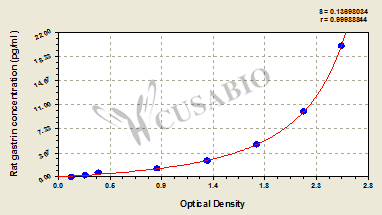This rat gastrin (GAST) ELISA kit employs the quantitative sandwich enzyme immunoassay technique to measure the levels of rat gastrin in multiple samples, including serum, plasma, cell culture supernates, or tissue homogenates. The enzyme-substrate chromogenic reaction is also used to amplify the signal and quantify the levels of the analyte through the intensity of the colored product. The color intensity positively correlates with the amount of gastrin bound in the initial step.
Gastrin is a peptide hormone that is produced in the G cells of the gastric antrum and duodenum and is then released into the blood circulation. Gastrin exerts its actions by binding to the CCK-B on the parietal and enterochromaffin cells of the gastric body. It is trophic for normal gastrointestinal epithelium. It primarily contributes to increasing gastric mucosal growth, gastric motility, and secretion of hydrochloric acid (HCl) into the stomach. Studies have shown that gastrin is involved in the stimulation of growth of several gastrointestinal cancers including gastric cancer.






